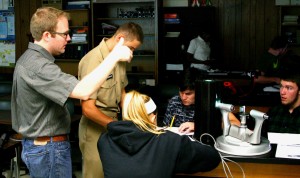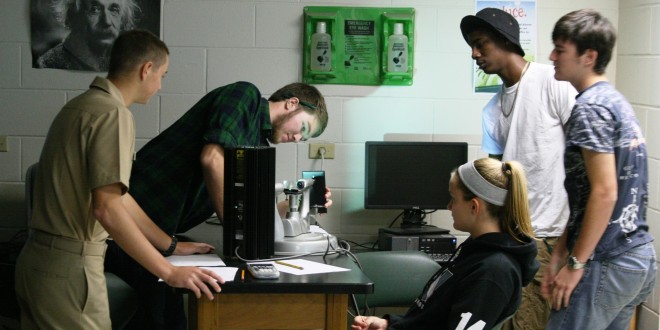The Lab Report may be a tradition science educators and students love to hate, but to get around it and inspire his introductory physics students to boot, Physics Professor Brian Lane found another, more personalized approach: weekly letters home.
As part of an approach he calls “Letters,” students in Lane’s classes are now required to e-mail a friend or family member back home about the work performed in labs each week.
 It’s caught on so well that Lane is even gaining attention from physics contemporaries across the country. An article he wrote about his method in the October issue of The Physics Teacher, a monthly peer-reviewed journal of the American Association of Physics Teachers, was the publication’s most downloaded story for the month.
It’s caught on so well that Lane is even gaining attention from physics contemporaries across the country. An article he wrote about his method in the October issue of The Physics Teacher, a monthly peer-reviewed journal of the American Association of Physics Teachers, was the publication’s most downloaded story for the month.
“The students love this assignment,” said Lane. “They write with enthusiasm and detail, and develop a better appreciation of our time in lab when faced with the question, ‘How am I going to explain this lab to my parents?’”
One student, for example, wrote about the relationship between frequency and wavelength, including photos, charts and graphs.
“Another student wrote his first letter home to his grandmother, who was so excited to receive it because she wasn’t allowed to take a physics class when she was in high school,” he said.
Since the article’s publication, Lane has received numerous requests from readers for more information, particularly for the assignment instructions and grading rubric he uses. One high school physics teacher was especially interested because she has a number of exchange students from China and sees the assignment as a way to help them connect with their families.
The seed for Lane’s idea was planted in ongoing conversations with English Professor Ed McCourt about the challenges educators face to make writing assignments authentic.
“What good does it do,” Professor McCourt argued, “for students to write a paper to an instructor about information the instructor already knows?” Lane said. “Where’s the motivation to really explain the subject? And how does this kind of writing prepare students for professional writing, where your reader is looking to learn information that is new to them?”
Everything gelled together when Lane, while teaching a quantum mechanics segment in spring 2013 on the photoelectric effect, half-jokingly told his students they should go home for spring break “and tell your parents you discovered the photon.”
“I said to myself, ‘Hey, that’s not a bad idea!’ and began making instructions and a grading rubric for the Letter Home assignment,” he said. “As I thought about how this assignment would help students find support for their studies from back home – something my mother, a kindergarten teacher, has always spoken passionately about – I became even more excited about trying it out. I was not disappointed and have used this assignment in my introductory courses ever since.”
The project has produced tangible benefits in the classroom – and for Lane, too. Students typically write the letters in an e-mail a day or two after lab concludes. Sometimes, this leads them to realize they missed a step, Lane noted, and they have to review the lab activity with their classmates or Lane to make their writing more complete.
“The letter home offers many advantages over the traditional lab report,” Lane writes in his article. “In order to explain the lab in the letter home, students must engage cognitively during the activity and internalize the concept so that it becomes their own, emphasizing the ‘writing as knowing’ paradigm.
“I have found letters home to be much easier and more enjoyable to grade than lab reports, without having to sacrifice the rigor of the students learning experience,” he continues. “I have also found fewer instances of plagiarism with letters home, as the assignment must be personalized to the recipient.”
To read Lane’s article from the October issue of The Physics Teacher at the website www.scitation.org, click here.
 Wave Magazine Online Jacksonville University News Hub
Wave Magazine Online Jacksonville University News Hub
